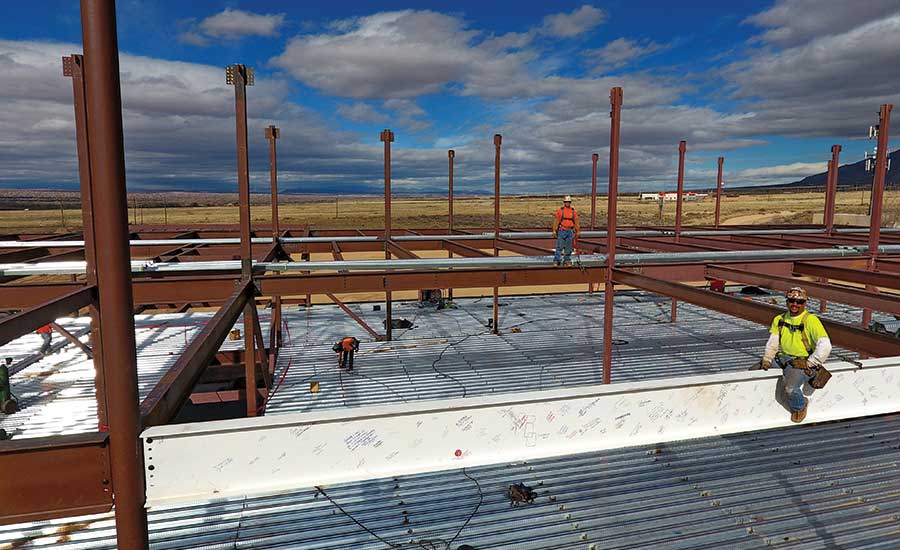With its long history of working on major projects, construction firm Bradbury Stamm is synonymous with New Mexico. Now in its 93rd year and fresh off a successful ownership transition, the firm is still building many of the signature projects in the Land of Enchantment, including the Albuquerque Rapid Transit project.
Cynthia Schultz, the firm’s 38-year-old CEO who transitioned into the role after her father, Jim King, retired from the chief executive position, says she’s bullish on Bradbury Stamm’s future.
“I just want to keep the company strong and not diminish the great vibe we have and a staff that can build anything,” Schultz says.
Those who work with Bradbury Stamm praise it as one of New Mexico’s elite general contractors, highly worthy of selection as the ENR Southwest Contractor of the Year.
“The quality is at the highest level, be it service, craftsmanship or delivery.”
– Rick Henrard, Director of Planning Design and Construction, University of New Mexico
“They’ve got great people,” says Rick Henrard, director of planning design and construction at the University of New Mexico. “The quality is at the highest level, be it service, craftsmanship or delivery.”
President Dennis Towne says the firm has “made it through the next-generation challenge and through the transition flawlessly. We have an amazing group of leaders …. I couldn’t even imagine working anywhere else.”
Towne adds he joined the company more than 20 years ago because it was building the best projects in New Mexico, and not much has changed. The company is a leader on the $83-million Albuquerque Rapid Transit project, a 9.6-mile bus rapid transit system running down Central Avenue (Old Route 66) in Albuquerque.
When complete, the project will redefine New Mexico’s largest city, says Mike Puelle, CEO of Associated General Contractors of New Mexico.
Other major projects include a new public K-8 school in the Albuquerque area; an expansion of Faith Baptist Church in Artesia, N.M.; the East Mesa Solar Project in Las Cruces, N.M.; Central New Mexico’s Smith-Brasher Hall facility in Albuquerque; the Stirling Apartments in downtown Albuquerque; two schools in Deming, N.M.; and New Mexico Mutual’s $18-million new headquarters. On the University of New Mexico campus, the firm is renovating the Farris Engineering facility, along with a new physics and astronomy building.
A ‘Family Business’ Business
Schultz describes Bradbury Stamm as a family business. “I have worked there my entire [professional] life,” she says. “I grew up incredibly proud of this company.” And over the years, she has come to realize the significant impact the firm has on the community.
Towne says he’s a big believer that a company and its employees function just like those running it.
“I was fortunate enough to work here for quite a while when Bob Stamm was still here,” Towne says. “I can’t tell you how many times he talked to me about how to be a successful owner: You need to take care of owners, subcontractors, workers and designers.”
Schultz’s father managed the business through the sometimes economically tough 1980s and encouraged her to look into other fields.
Schultz earned a bachelor’s degree in economics from the University of Chicago—“not a typical path into construction,” she says. Schultz followed that up with a master’s degree in construction management from Arizona State University.
After joining Bradbury Stamm, she worked in different roles, including on the Bernalillo County Metropolitan Courthouse before being named president in 2011.
Her transition to company head started six years ago, and she worked closely with Towne and Lawrence Peterson, senior vice president.
“There was a struggle there to learn how we were going to transition the company, and we decided to do it ourselves,” Schultz explains.
“We also [had] created a few different divisions or departments [and] I worked to eliminate that,” she adds. “That was a big thing—we need to be one company.”
Schultz says her father comes into the office for a few hours a day and is still her No. 1 resource.
Along with quality, another factor that drives Bradbury Stamm’s success: “Bob Stamm cared first and foremost about reputation of the company—that came before profits,” Schultz says. “We don’t make short-term decisions.”
And that includes asking themselves a lot of questions such as, “Will I be proud of this project in 10 years?” she says.
The firm also stays out of political debates, allowing employees to “keep it simple,” stay away from distractions, cut down on stress and resolve issues quickly to focus on the clients, Schultz says.
“We’ve continued to respect experience by having a good mix of veterans with younger employees,” she adds.
National Competition, Local Loyalty
As a whole, women are a small percentage of the construction industry, be they management or employees. Four of Bradbury Stamm’s senior project managers are women.
Now a married mother of two, Schultz remembers watching her father on a TV interview when he credited women for the firm’s success.
“Bradbury Stamm had female project managers in the early ’90s, which was unusual for that time,” Schultz says. “I grew up with a company where that was not an issue.”
She believes that women will play a greater role in the industry in the coming years.
In a shifting market, “everything is pretty much a qualification-based selection,” Schultz says. “New Mexico has provided enough work to keep us busy and we’ve picked up market share.
“We don’t go out and seek small projects, but we do them for the clients we care about,” she says. “You’ve got to do everything to stay at the size that we are.”
The firm grossed $187 million last year, and “I’d be surprised that we don’t reach $350 million [in 2017],” Schultz says. “It’s organic growth.”
Part of those future revenues can be attributed to the rapid transit project, while a lot of it will stem from a strong foothold in Colorado, she says.
Bradbury Stamm’s first public works projects in Colorado are relatively small, which “was a nice way to start,” Schultz says.
“We have been hiring staff, and we think we have a long-term future [in Colorado],” she says.
The firm has also made minor inroads into Minnesota with the purchase of Winkelman Building Co., now a wholly owned subsidiary.
“We are able to take this on even though it is not a natural geographic move to go up to St. Cloud [where Winkelman is based],” Schultz says. “We feel like things are going well; we have built up the staff ahead of it.”
Schultz says the recent geographic expansion is a continuation of the firm’s efforts at pushing the envelope to become a better company. For example, as the Great Recession loomed in 2008, Bradbury Stamm prepared itself to hire solid talent and keep them busy while attracting projects as other firms downsized.
Around the same time, national firms vied for New Mexico projects, which made Bradbury Stamm “work harder to keep up and provide all the services a national company would,” Schultz says.
During that same time, the firm invested in new technology, like the latest iPhone, to assist employees in doing their jobs better. As a testimony to how the company has progressed, Schultz says her father went to work for Bradbury when it was the only construction business with a computer.
No matter how much Bradbury Stamm may branch out in the U.S., Schultz says her firm is dedicated to New Mexico. “This will always be home,” she says.
John Guzzon contributed to this article.




